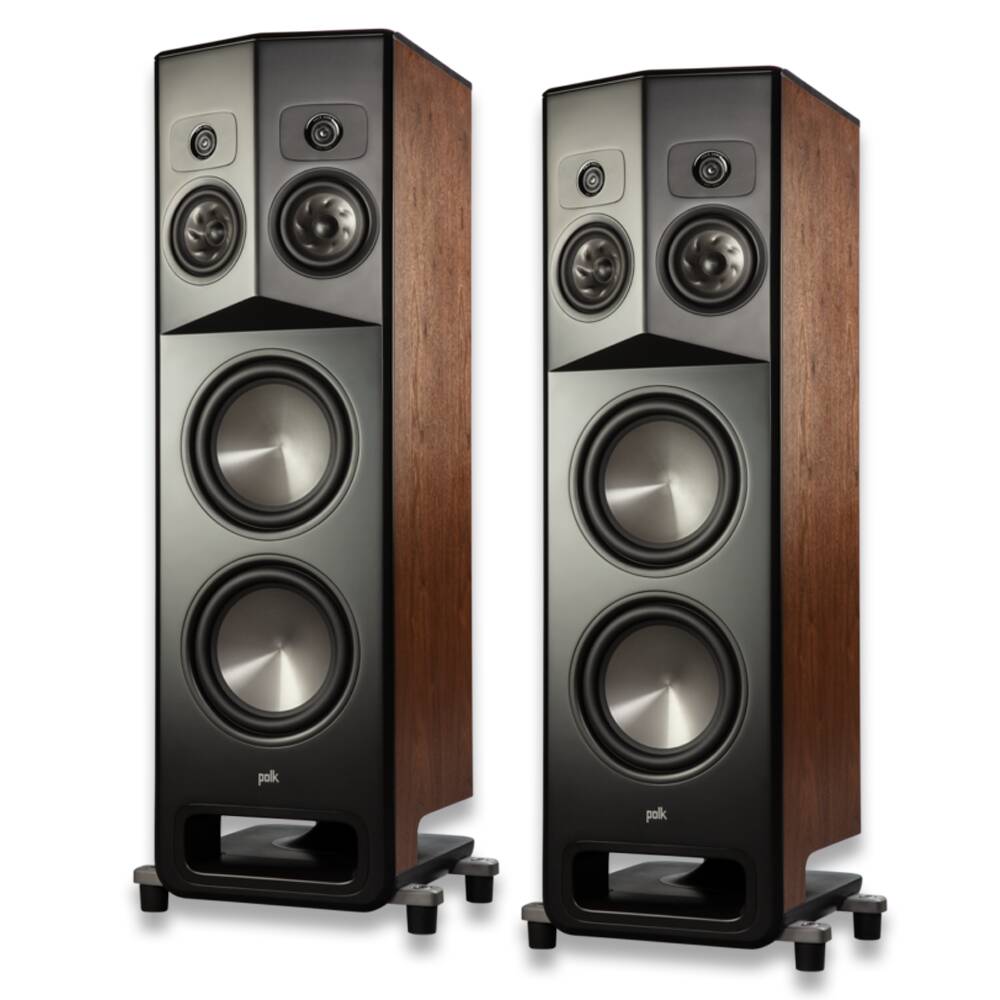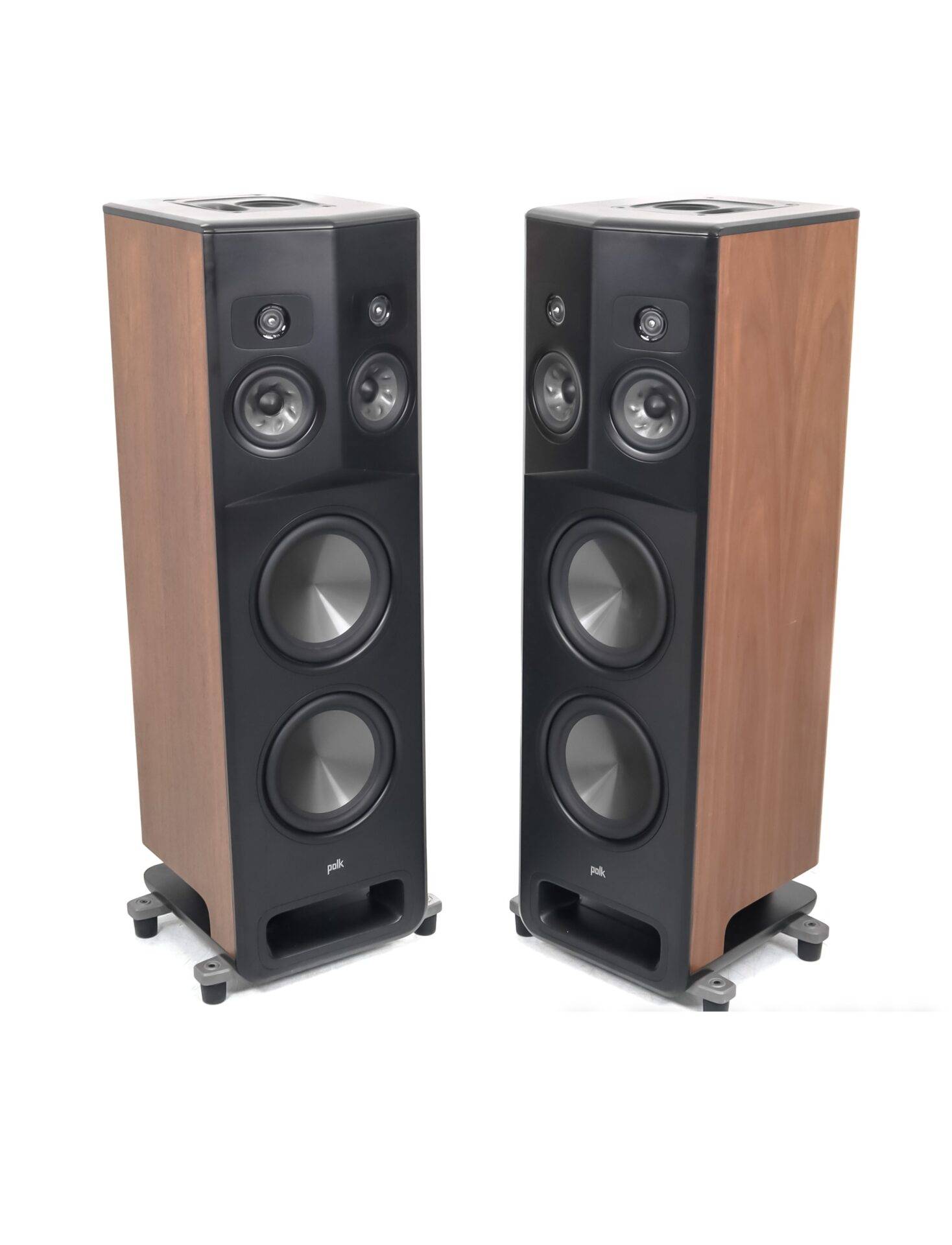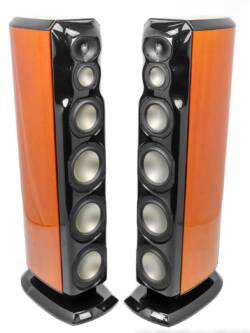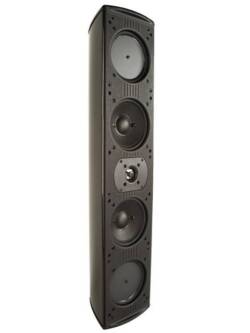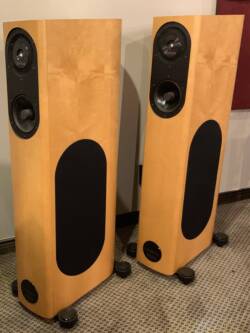Polk Audio Legend L800 Loudspeakers
Original price was: R125,000.00.R70,000.00Current price is: R70,000.00.
If you want an immersive experience that no other technology can deliver, the L800 speakers are for you. Built on the legendary SDA technology that became synonymous with Polk innovation, you will be absolutely blown away by this true flagship experience. Note: These speakers are sold individually with specific Left and Right variations. You must add both to your cart to receive a stereo pair.
- Dual 10″ drivers & 5.25″ Turbine Cone woofers
- Dual 1″ Pinnacle Ring Radiator tweeters
- Enhanced Power Port® for better bass
- Iconic cabinetry engineered for max performance
- SDA-PRO technology for lifelike stereo imaging
Description
Polk Audio found enormous success with their former flagship loudspeaker line, the LSiM series, which were launched in early 2011. However, after nearly a decade, Polk thought it was time to refresh their top-of-the-line speakers. In late 2019, Polk launched their ‘Legend’ speaker line which supplanted the LSiM series. The announcement of the L800, the big dog of the ‘Legend’ series, caused a wave of excitement throughout the audio community. This excitement was not only due to the heavy-duty specs on the L800 but also the return of Polk’s SDA technology that Polk had left dormant for nearly 25 years. The L800 was by far the most ambitious loudspeaker that Polk had ever launched, not to mention the most expensive.
At long last, we finally bring you our review of the L800 speakers. This is not a simple speaker, and that was one of the factors in the delay of this review (there was also a pandemic to contend with, a new addition to my family, and also a cross-country move, so life can get in the way of these things as well). The L800 is a unique and relatively complex design for a loudspeaker, but what it delivers is one of the best soundstages that you could ever hope to hear from stereo sound from any speaker set at any price. Its advantage is the SDA technology, updated and improved from its former incarnations, now dubbed the ‘SDA PRO.’ The SDA technology does have some catches though, such as some rather particular placement requirements, a strong preference for single-ended amplifiers, the need for an extra cable that joins the speakers, and a bit more treble than the highly neutral response that the L800s produce with the SDA disengaged. However, what we get for these trade-offs is a speaker that images like none other, regardless of price.
Packing and Appearance
The L800s were very well packed. They were double-boxed with thick polyethylene foam blocks giving them a good distance from the box walls. They were wrapped in a soft fabric bag to protect them from slight scuffs or scratches with an outer plastic back to protect them from moisture. With 150 lbs. shipping weight per speaker, unboxing them was an elaborate ritual unto itself as we demonstrated in our L800 Unboxing YouTube video. Once unpacked, we were met with a speaker with formidable presence (a fancy way of saying it’s a big ‘un). Polk has taken strong measures to make them as visually palatable as possible, and I think they do look pretty cool, but they are so large that they certainly wouldn’t be acceptable for everyone.
I should say here that when I say they look cool, I don’t mean to say they look elegant or gorgeous, which I don’t think they do. I think they look interesting and somewhat bold. Polk has tried to temper this with some rather traditional finish options where the user can have walnut side panels with a satin black front baffle or black ash side panels with a gloss black front baffle. These finishes are very nice and I would say furniture grade. They need to be furniture grade since the L800s are so large that they do have the presence of furniture. Without grilles, all of the drivers on the front baffle, especially across the SDA array, make the L800s look a bit busy compared to most speakers. The two 10” bass drivers give it a very beefy and capable appearance, and the SDA array makes it look like it could really rock the house, although, as we will discuss below, the outer set of drivers are there to eliminate sound, not add sound.
Polk Audio L800 Unboxing Overview
The grilles do a great job of muting the busy facade of the front baffle and make the L800s look rather stoic. They are magnetically attached, so there are no visible grille guides on the front baffle. One nice touch of visual flair is the dividing angle front baffle of the SDA array that the grilles carry all the way down the speaker. This slight wedge shape of the front baffle is not there for stylistic reasons, but rather practical concerns that I will explain later. However, I think it is the key ingredient in the neat look of these speakers. While this is an overall angular speaker, there are no hard edges since all of the edges have a slight rounding, and that certainly helps the L800s to look less aggressive than they could have, and that adds a touch of class to what might otherwise have been a bit more brutish appearance.
Design Analysis
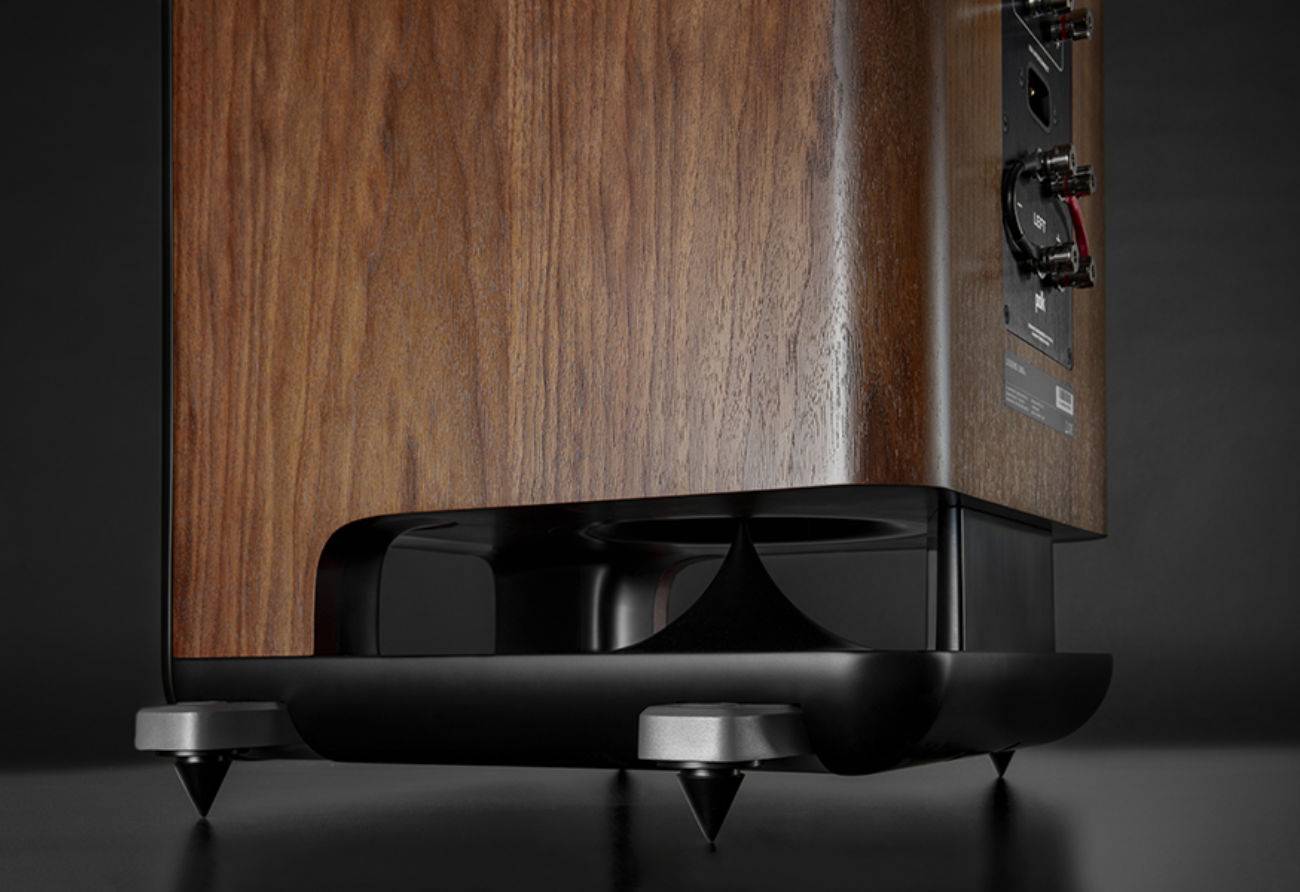
The L800 has a lot going on. Even setting aside the SDA technology, there is much to distinguish it from other speakers in its class. In discussion with the L800’s engineering staff, I was told that the L800 was first designed to be the best speaker they know how to make. The SDA technology was then layered onto that speaker. Let’s talk about some of the more normal features that it employs to improve performance before we get into the SDA stuff. Its base design is a three-way tower speaker using 10” bass drivers, 5.25” midrange drivers, and 1” ring radiator tweeters. The drivers that it uses are all new and custom made for the Legend series. For a detailed discussion of these elements, let’s start at the top with the ring radiating tweeter. Polk has been using ring radiator tweeters for decades, and this iteration of their ring radiators, which they call the ‘Pinnacle Ring Radiator,’ is their most refined version yet of this tweeter type. Why go with a ring radiator and not the usual dome tweeter? I will quote from Audioholic’s review of the Legend L200 and L400 which uses these same components:
The way ring radiators work is that instead of having the voice coil former affixed to a dome as in traditional dome tweeters, the voice coil former is simply connected to two large soft ringed suspension pieces: an outer ring and an inner ring. The inner ring is connected to a stationary rod in the center that also holds that needle-looking phase plug. Whereas in normal dome tweeters, the acoustic radiating surface is the dome, in a ring radiator, the acoustic radiating surface is these two large suspension rings. Normally the suspension bits in drivers are used merely to hold an acoustic radiating surface in a manner where it only has one plane of travel, back and forth.
One of the advantages of ring radiators is that ‘break-up’ modes are pushed out to much higher frequencies versus typical dome tweeters. ‘Break-up’ modes are where the radiating surface, whether that be a dome, cone, or plane, loses its shape from playing frequencies so high that it bends only part of the surface instead of the entire surface. It can really hurt the sound quality from any speaker where it is not controlled. Another advantage is that ring radiators can easily play to ultrasonic frequencies since the soft suspension piece being driven is usually much lighter than traditional dome materials.
The midrange driver was also nicely explained in article:
…the midrange driver is a unique design in the Legend series. The cone is made out of foamed polymer and is peculiarly shaped such that Polk calls it the ‘Turbine Cone.’ The cone has seven fin-type protrusions that form a vortex pattern hence the name ‘turbine.’ The shape and number of these fins are claimed to make the cone stiffer which can drive break-up modes higher in frequency where they will be easier to filter out by the crossover circuit.
 Each L800 uses two 10” bass drivers that are very capable. I like to listen to music and movies loud, and in my time with the L800s, I was never able to get them to bottom out or even hear any mechanical stress. The bass section of these speakers is so proficient that it would have made for a pretty good subwoofer in itself separate from the speaker. They use the same foamed cones as the midbass drivers and a large surround and are capable of much more air displacement than most speakers in its price class. Polk was able to use these large woofers since the speaker already had to be wide due to the SDA array, thereby allowing for larger and more serious bass drivers. For the lowest octave, these bass drivers charge a bottom-mounted port that Polk calls the ‘Power Port.’ Again, taking from the description from our previous Legend review:
Each L800 uses two 10” bass drivers that are very capable. I like to listen to music and movies loud, and in my time with the L800s, I was never able to get them to bottom out or even hear any mechanical stress. The bass section of these speakers is so proficient that it would have made for a pretty good subwoofer in itself separate from the speaker. They use the same foamed cones as the midbass drivers and a large surround and are capable of much more air displacement than most speakers in its price class. Polk was able to use these large woofers since the speaker already had to be wide due to the SDA array, thereby allowing for larger and more serious bass drivers. For the lowest octave, these bass drivers charge a bottom-mounted port that Polk calls the ‘Power Port.’ Again, taking from the description from our previous Legend review:
“The idea behind the Power Port is that it preserves the laminar flow of air within the port by controlling its contact with the environment from a flared cone piece that is mounted over the port opening. This should protect against port turbulence at higher drive levels better than traditional port designs.”
For the L800, Polk calls the crossover design the ‘Orth’ crossover circuit, naming it after the lead designer at Polk, Scott Orth. The Orth crossover is not a crossover type so much as it is a set of guidelines that Mr. Orth likes to use in crossover design that is recounted in the design analysis section of the above-quoted L200/L400 review. The L800 crosses the bass drivers over to the midrange driver at 370Hz and goes from midrange driver to tweeter at 2.8kHz. The exact slope is not provided, but is said to be around 3rd order on the midrange and tweeter. Crossover parts were also not easily accessible, but it is my understanding that they are good quality for the money rather than cost no object. The crossover circuit would have to be very elaborate for a speaker of this complexity. The L800s have dual binding posts for bi-amping or bi-wiring options (we regard bi-wiring as ineffectual and don’t encourage it). While bi-amping is normally an excessive and unneeded feature on many loudspeakers meant for home audio, that is not the case for the L800s. With a specified 87dB sensitivity, these are not extraordinarily sensitive speakers, yet they can take a lot of power on account of the dual 10” bass drivers. Users could bi-amp these speakers and run the bass driver section on a really beefy amplifier, and the L800 can actually take advantage of that power unlike so many other home audio loudspeakers.
The cabinet is very stout with a network of internal bracing that includes a sealed compartment for the midrange drivers. There is a removable plate at the top which gives users the option to install an up-firing Atmos module. We didn’t receive an Atmos module, which must be purchased separately by users, and so we will not be covering that aspect of the L800, except to say that it looks like it could work somewhat better than most Atmos modules by virtue of being sunk in the cabinet so that less of the sound from the speaker will hit the user directly. Ideally, users will only want reflected sound to reach their ears from Atmos modules, not direct sound. The grilles are touted to be acoustically transparent by Polk. While no grille is truly acoustically transparent, the L800 grilles look like their acoustic effects would be insignificant for practical purposes given the minimal frame. Users have the option of using either spiked feet for carpeted surfaces or rubber feet for hard flooring. The 5-way binding posts are solid and high-quality. They use a wire jumper instead of a chunk of sheet metal like most other speakers. The overall build quality is very good, as one would expect from a loudspeaker at this price point.
SDA Technology Overview
To put it simply, the SDA technology eliminates or reduces sound reaching the listener’s ear from the opposing side speaker, so that, for example, sound from the left speaker is not heard by the right ear. This improves the imaging ability of the sound system. To go into more detail, we are going to get a bit technical.
The above-mentioned effect of sound from one of the stereo channels reaching the opposite-side ear is called inter-aural crosstalk. In theory, you would want sound from the left speaker to only reach the left ear and right speaker to only reach the right ear. Inter-aural crosstalk is a distortion that “smears” the imaging in the sense that it makes the speakers themselves more localizable and thus restricts the sound image between the speakers. Headphones have no inter-aural crosstalk and so the headphones themselves can’t be localized, and this is why headphones have large spacious images. However the headphone sound is stuck inside the listeners head (a lack of externalization) and doesn’t sound very realistic. The reason for that is the sound from headphones bypasses many of the acoustic effects of our head, ears, and body. In addition, headphone sound doesn’t change with respect to head movement. Only extremely sophisticated headphone systems can overcome these flaws, and presently those only reside in laboratories (though are becoming increasingly common in less costly products).
At this point, we might ask how much of a problem is inter-aural crosstalk in reality? Many of us have experienced great imaging from speakers that don’t have SDA technology, so how much of a difference has inter-aural crosstalk been shown to make? Of course, a lot of research has gone into recreating a soundscape more accurately, and one of the problems with 2-channel systems is that they contain various “distortions” that prevent the proper illusion. The biggest “distortion” preventing a 3D presentation of the soundscape is that the way in which the actual sound object is reproduced is not realistic, and one example is that the sound object is a virtual object created by a pair of speakers which radiate sound differently from how that actual sound object would. That radiation problem causes crosstalk between the ears and as such, you get a smeared reproduction of the sound object. In practice, we are used to this and it doesn’t destroy the effect, but that doesn’t mean it’s realistic or accurate.
There have been various measures over the past decades to reduce inter-aural crosstalk. Crosstalk cancellation and stereo expanders were popular in the 80’s, but many found the effect artificial (in reality, the effect is “more” realistic, but often introduced its own distortions). A problem with most of those crosstalk cancellers is that it requires a narrow listening window in order to hear the effect to its best advantage. One experiment, by Timothy Brock and Don Keele, eliminated inter-aural crosstalk by simply using a physical barrier that extended from between the speakers to the listener’s head. They note that this creates very realistic imaging which expands over a full 90 degrees, yet the speakers were very close together while still achieving a massive soundstage that is far beyond the confines of the speaker locations.
Crosstalk cancellation solutions have often been problematic in that they required unacceptable compromises in listening (sitting in only one perfect spot, large added barriers in a room, added sound colorations, etc.) The key is to understand that the love affair with crosstalk cancellation is not that it was a neat effect, but rather it was a search for more realistic imaging; what many call a fun effect is actually more realistic. The problem is that we aren’t all that bothered by the distortion since we are used to hearing reproduced sound that way, so we often perceive normal speakers as being “more” natural. It is only more natural in the sense that it is naturally what a pair of speakers does and is thus what we are used to. It is not more natural in the sense of how we locate real objects in space.
Polk’s Stereo Dimensional Array (SDA) addresses a real problem but may not be one that bothers many. The advantage of the SDA approach is that it does not lock you into a small optimal listening window. You can still move your head around and hear the effect. Furthermore, at the right listening distance, multiple listeners can enjoy the benefits without much loss of fidelity. The negative is that, like other systems, it does introduce a small but noticeable timbre distortion.
SDA is a kind of analog acoustic crosstalk cancellation. It uses speaker drivers placed precisely the distance between the average human ears on each cabinet to achieve crosstalk cancellation. The outer midrange driver and tweeter of each L800 speaker produces an inverted signal of the opposite speaker. This is an attempt to cancel out the sound of one of the speakers from reaching the opposite side ear. The cancellation method is similar to how active noise cancelling headphones work; generating a sound of the same amplitude but opposite phase negates the original sound. Polk’s new “Pro SDA” updates the original SDA by incorporating improvements including headshadow response, which allows the SDA cross-talk cancellation to be expanded into the treble region without serious interference problems. The Pro improvement adds a 15-degree baffle angle which helps narrow the speaker overall while also building in the toe angle needed for best sound. The new technology does a better job matching the true interaural crosstalk distortion created with most speakers and thus more completely cancels it.
Many will ask why this SDA technology is needed. After all, if we listen to an instrument in a room, do not both ears hear that instrument, regardless of its placement? Is this really a distortion we should be concerned with? Keep in mind, first, not everyone agrees this is the right solution to the problem it is trying to solve. Inter-aural crosstalk cancellation helps a speaker act more like a headphone allowing for the accurate reproduction of binaural recordings. It works well with normal recordings as well, but with diminished effect. The purpose is to more accurately recreate the original sense of space in the recording. The crosstalk distortion tends to diminish our sense of space we hear from the recording and rely more on the room’s ability to reproduce that sense of space. While some will argue this is a solution in search of a problem, others will argue it is solving a very important problem impacting the realistic reproduction of sound. What do I think? Decide for yourself after hearing them setup right.
Setting up the L800
The L800s are an unusual speaker and so setting them up is also a bit unusual. Whereas many speakers are recommended to have the listener position form an equilateral triangle with the left and right speakers, the L800s work best when they are positioned much closer together than typical placements, so the speakers should be much closer together than you are from them. As an example, for a listening distance of 8’, a speaker spacing distance of 5’-6’ works best. For a distance of 10’, 7’-8’ apart might make the most sense. A certain minimum distance apart, say 4’-5’ seemed necessary, but placing the speakers farther apart did not widen the image, it simply ruined it. If you’re able to listen at more than 10’-12’ back from the speakers, it may still make sense to try the speakers at a narrow 6’ to 8’ apart, and you might find the 6’ distance still sounds best. Moving the speakers farther apart, when at a sufficiently far listening distance, increases the optimal listening window and allows more people to enjoy good sound. However, the key is sufficient listening distance. While 8’ apart is enough to allow 3 people across to enjoy the imaging, you would need to be about 10’ to 12’ back at a minimum for this to work well.
The near wall placement and close distance apart makes these ideal speakers for many people’s homes where the speakers can be placed on either side of a TV pushed against a wall. This normally degrades imaging for normal speakers, but with the Polk L800s, it is ideal. They will recreate a giant image that extends beyond the walls of the room even in this placement (in fact, because of this placement). If the speakers are pushed too far apart, the image shrinks, and the inter-aural crosstalk cancelation is diminished. This near-wall placement also helps to reinforce low frequencies through boundary gain which strengthens bass.
The SDA speakers require sound from each speaker to be sent to the other speaker 180 degrees out of phase, and this is done via what Polk calls an ‘umbilical’ cord. Polk includes two umbilical cords that are each 12’ long. They can be connected together for a 24’ length which can be useful in case you need to route the cables around something. The cable is quite substantial and reminds me of those high-end audio cables with oversized jackets. The umbilical cords are probably better than they needed to be. The have a proprietary connect that utilizes a banana plug and jack on each side. This would be difficult to DIY, so the factory cable is necessary.
One important set up point is that differential output amplifiers will not work as well with the SDA technology. The SDA feed comes from the positive leg of the speaker inputs. With single-ended amplifiers, that gives all of the difference signal, but with a differential amp, you only get half of the difference signal. We tested both and found better sound with single-ended amplifiers. Most modern Class D amplifiers have differential outputs and won’t work well, such as the Cherry Megachino I tried, the Hypex based amplifiers (including Marantz’s own Reference PM-10), various NAD amplifiers, etc. Most amplifiers in general are single-ended output so finding a good amplifier that works is not a big problem. The best way to tell is to look at the back of the amplifier and see if it notes that the negative terminal of the amplifier cannot be connected to ground or if it is referred to as a balanced output or differential output amplifier. If all else fails, ask the manufacturer.
When the L800s were used in my room (11’ wide), we found the best sound was achieved using a lot of early reflection absorption. It seems the inter-aural crosstalk cancelation was negatively impacted by sidewall reflections. We confirmed this using binaural recordings. It suggests that if the speakers are within 3’ of the sidewalls, it may make good sense to add a lot of sidewall absorption. This can be achieved with purpose made acoustic panels, but thick curtains would do a similar job. Crosstalk cancelation happens over a limited and mostly mid to high frequency bandwidth.
Listening Sessions
Listening was done in my home theater room, which is 11’ by 25’. After much experimentation with placement, I found the best sound was when the speakers were separated by about five feet, with my listening position being eight feet away. The equipment used was primarily an Acurus A200 amplifier with a Cherry Dac Dac HS, using a laptop as the source. The media used was mostly streaming sources such as Qobuz, Tidal, and Amazon HD, but I also listened to some compact discs. For my music listening, I created a playlist of albums that were mixed or recorded in a way that could demonstrate the theoretical advantages of the L800s. I also played some more typical music just to see how the L800s fared on standard musical content.
One album I listened to was ‘The Immaculate Collection’ by Madonna that had been remastered using QSound processing. Qsound is a filtering algorithm that creates binaural recordings of mono sources (meaning individual instruments or voices) that makes for a large, expansive soundstage. Some have criticized the album for the artificial nature of the QSound effect. However this effect, like SDA, is in fact “more real” in terms of object placement. Since the songs were not originally produced with QSound in mind, it is fair to say that it may not have been what the original artist and producer intented, though if they were involved in the remaster, it may also be described as a re-imagining of what the songs could have been.
The album changes the songs enough that it is not my favorite version, but the QSound effect is obvious and worked well with the SDA technology. Per the track ‘La Isla Bonita,’ as compared to the standard version, the harmonizing voices had a larger and more expansive sound coming from well beyond the speakers and giving a sort of ethereal quality to the song. A good anchoring bass line came through clear and tight; this is not a particularly bass rich song and Polks reflected that properly. A flamenco guitar had a nice center floating sound as if coming from just beyond Madonna. I found the sound of the guitar to be neutral and accurate. On the track ‘Like A Prayer,’ Madonna’s voice has a reverb effect and harmony that pulls her voice, over time, to the left of the image. On normal speakers this effect is barely noticeable. On headphones it is pronounced, and it was replicated accurately by the Polks. It had the effect of enlarging the sound and adding a great sense of space between the instruments and musicians.
One album that really shined on the L800s was ‘Wandering’ by musician and acoustic artist Yasi Horikawa. This is a binaural recording, meaning that it was recorded with a microphone set up in a dummy head that mimics human hearing, and this gives recordings a hyper-realistic effect that is eerie to listen to, especially with real objects. This album sounds merely ok through normal speakers, but most of the effect is lost. Headphones lock the image in your head, but the binaural effect is obvious. Using the Polk speakers, it was the first time I heard this album as it was meant to be heard, giving the same realistic binaural sound I hear over headphones but without the problems of the image being locked in my head. Instead, the image expanded over 180 degrees in front of me, expanding far beyond the boundaries of my wall. On the track ‘Bubbles,’ the sound of marbles falling on a hard surface creates a rhythm for the music while at the same time catching your attention to what sounds like actual giant marbles falling all around you. It’s hard to describe what this is like until you hear it. Listening to it through headphones gives you a sense, but it feels different when you hear it outside your head. Regular speakers simply can’t achieve this. As compared to other more conventional speakers, the imaging is different- more laser-focused and generally coming from between the speakers. The width of the image largely depended on how far the speakers were spread apart. The bouncing marbles were thus relegated to just between the speakers. And so on normal speakers, the depth was lost, the size became smaller, and the effect no longer sounded real. Cool sure, but not the same.
The 50th anniversary remaster of the Rolling Stones’ ‘Let It Bleed’ features some very vivid stereophonic effects, and I thought this would make for a good demo of what the L800s could do. For example, the track ‘Country Honk’ starts with a car driving by and honking. Through my typical reference speakers, the effect was best described as normal; it sounded real, I suppose, as much as any normal speaker can sound real in this regard. However, I didn’t sit up and think, hey there is a car in my room. With the Polks, I was honestly startled by the hyper-real sound of the car. While I knew there wasn’t a car in my room, it really had that kind of presentation. The song has a great rhythm that makes you want to tap your foot along. I’ve heard it so often before that I don’t get into it as much as I used to. I recognize it as a great song, but I’ve simply played too much. Yet through the Polks, I felt like I was hearing it again for the first time. I can’t explain why, beyond the special imaging, but I found myself relistening to a lot of my favorite music without feeling like it was played out. This was just one of many examples where that was true.
To see how the L800s dealt with orchestral music, I listened to the album ‘Celebrating John Williams,’ which is performances of John Williams compositions by the Los Angeles Philharmonic Orchestra led by Williams’ friend Gustavo Dudamel. This high-resolution recording was released in May of 2019 on the Deutsche Grammophon label. Through my reference speakers, the soundstage of this album was large and expansive, and the instruments were layered in a realistic way. At the same time, I would say it didn’t sound real to me. The narrow directivity and highly specific imaging that that creates has always caused symphonies to sound artificial. You simply can’t hear image placement that well in a real symphonic hall. In addition, while the image was large and expansive, that is caveated by the fact that it was still limited to the confines of the room. It never sounded like it was realistically large, but I don’t find most any speaker able to realistically portray what an actual symphony sounds like in real life. However, through the Polks, I found the imaging much more realistic. The size was larger than my room, and with the lights off I felt I couldn’t tell I was in my room anymore. It easily expanded beyond the confines of the walls, let alone the speakers themselves. Symphonies often have solid bass down to at least 50hz, with some instruments producing sound even lower than this. Often quite loud! The Polks had such good bass that, when paired with a powerful amplifier, they sounded realistic in size and dynamics. This recording also exposed the shortcomings of weak amps. The dynamics of the music often stressed the small amps built into receivers when trying to play back at realistic levels.
I listened to a lot of Pink Floyd, naturally, since their characteristic stereophonic effects were something that I thought the L800s would be a great fit for. One of many examples of how well the L800s rendered Pink Floyd came on the track ‘Time’ from ‘The Dark Side of the Moon.’ The sound of clock ticks came from all around the 180-degree hemisphere in front of me. I won’t exaggerate, as some reviewers have, and suggest it sounded like it came from all around me. It doesn’t do that (and the science behind inter-aural crosstalk cancelation suggests it shouldn’t and that it only impacts the sound from in front of you). Still, the effect was to present the recording in a new and different way from what I am used to. It was best described as listening to a giant pair of headphones. It wasn’t stuck in my head, but it also wasn’t stuck between a pair of speakers. The drumbeat that moves around the stage normally sounds like it is coming from just between the speakers. This gave the impression that the drums expanded out beyond my room’s boundaries – a very cool effect that added to the musical presentation. The Polk L800s were seemingly made for Pink Floyd; no other speaker presents their music and style of mixing so accurately.
The L800s can bring out new aspects of older recordings that can make them engaging to give a relisten. One example of that is the HD remaster of Ray Charles’ ‘Hallelujah I Love Her So.’ On the track ‘I’ve Got a Woman Live,’ the recording starts with audience applause. It should sound like it’s coming from all around but normally sounds like it’s coming well in front of you and between the speakers. Through the Polks, it sounds like it’s coming from around you, though it primarily still sounds like it is at or in front of you but not in an artificial manner. The perspective shifts from as if you are on a balcony listening in with the audience in front of you to sounding like you are there as part of the audience. The imaging of the recording is nothing special, with Ray positioned fairly hard to the left, playing piano, and his orchestra more center and to the right. Through normal speakers, this can sound a bit artificial, again, typically constrained between the speakers or just about where the speakers are at. Through the Polks this took on a different quality with it now sounding more like Ray was playing piano to the far left of the stage, far outside the confines of the speakers or room. Again, the Polks had this unusual and uncanny ability to cause the room boundaries to disappear. I think this is why I liked relistening to my old favorites so much.
I could go on with many more examples of how the L800s separate themselves from typical speakers, so I will just sum up their overall character from my experience. Firstly, they have the best and most realistic imaging I have ever heard, with the right music. The effect was strongest with binaural recordings, but any recording with a sophisticated use of stereo soundstaging stands to benefit. The SDA effect added noticeable timbre coloration, but wasn’t obvious on all music and often wasn’t offensive. The sound was alluring, causing me to revisit my music library for hours on end. These are very enjoyable speakers to listen to, even with their imperfections, and I wanted to listen to them more than other speakers. While they played plenty loud, they sometimes felt dynamically constrained. They seemed to need a powerful amp to sound their best. I should say at this point that I like to listen to music and movies at louder levels than most people. The L800s have more than enough dynamic range for the vast majority of people – with enough amplification. They were capable of loud deep bass, which sounded very good. However, they need big amps to achieve their full potential. They sounded noticeably constrained in bass with small receivers.
Polk Legend L800 Loudspeaker Conclusion
The L800 is such an eccentric speaker that it cannot be measured as a normal speaker would. Instead I employed a nearfield splicing method consistent with how Stereophile’s John Atkinson measures speakers. Due to the size of the speaker and size of the room I had to measure within, I was only able to measure out to 60 degrees on the horizontal axis. My results were shared with Polk’s engineers and Polks own internal measurements were shared back with me. Results were found to have a very high degree of agreement.
To measure the L800, I placed it on a 1’ stand on top of a lazy susan like device. The speaker was measured at a distance of 1 meter (with a conformation of response at 2 meters to ensure nearfield). It was measured in 5 degree increments out to 90 degrees, but I only kept those measurements not corrupted by reflections beyond use. Farfield measurements were windowed to remove reflections. Woofer and port were measured in the nearfield, and the woofer was also measured groundplane. Data was processed within VituixCad2 for display.
The above graph shows the direct-axis frequency response and other curves that describe the speaker’s amplitude response in a number of ways. For more information about the meaning of these curves, please refer to our article Understanding Loudspeaker Measurements Part 1. The L800s can be seen to have a very linear response and maintain a tight window from 40Hz to 20kHz. These are very accurate speakers. From these curves, we can see that the L800 has a very wide dispersion out to 5kHz and then begins to narrow a bit from there. At 10kHz and above, the dispersion becomes very narrow; this is not unexpected given what we have seen from the Legend series ring radiator tweeters in our L200/L400 review. The L800s are best listened to on-axis so that the tweeter faces the listener. Those who are sensitive to high frequencies can simply listen at a slight off-axis angle to shear off exposure to treble output.
The above graphs depict the L800’s direct-axis and horizontal dispersion out to a 60-degree angle in five-degree increments. Information on how to interpret these graphs can be read in Understanding Loudspeaker Review Measurements Part II. These measurements show a speaker with very good if slightly idiosyncratic performance. The response is mostly flat and neutral on-axis. The speaker shows a slight rise, characteristic of all Legend series speakers, in the treble. However, as had already been noted, the tweeter beams noticeably off-axis in the high treble band, so the listening window maintains a neutral balance. The rise is also not that aggressive, being only a few dB’s as you reach toward 10khz. Again, we see that this is an accurate loudspeaker, if perhaps a tad forward due to the very slight treble rise. For those who want a warmer sound as well as the SDA imaging, it would only take a light touch of equalization to get there.
Note: All measurements were taken with the SDA drivers disconnected. Measuring the speaker with SDA active is very difficult to do accurately. While I did measure it this way, the manufacturer had concern that this approach was not accurately reflecting the response of the speaker.
The above polar map graphs show the same information that the preceding graphs do but depict it in a way that can offer new insight regarding these speakers’ behavior. Instead of using individual raised lines to illustrate amplitude, these polar maps use color to portray amplitude, and this allows the use of a purely angle/frequency axis perspective. The advantage of these graphs is they can let us see broader trends of the speaker’s behavior more easily. For more information about the meaning of these graphs, we again refer the reader to Understanding Loudspeaker Review Measurements Part II.
Here we can see that the bass to midrange dispersion of the L800 extends out to the 60 degrees that we were able to measure. We get a better look at the beaming that occurs at 5kHz and above. If you want to be met with the full range of treble out to 20kHz, you will need to be listening on-axis with maybe a +/-10 degree tolerance. The good news is that there is not much content in that extreme upper band between 15kHz and 20kHz, so even if you aren’t listening in that window, you won’t be missing much. That assumes that the listener can hear frequencies that high. Most older adults in industrialized countries have some level of high frequency hearing loss, especially in men older than 50, so there is a good chance that the reader will have trouble hearing anything in that frequency band anyway. Response issues in the high treble range of 15kHz to 20kHz is rarely of any audible consequence.
Conclusion
Anyone who has read this far will get that I enjoyed the Polk Legend L800 speakers. Those readers will also understand that these speakers are a bit more demanding than most in their set-up. The user needs to do a bit of accommodation in order to get the most out of them. Those who are willing to make that stretch will be rewarded with a phenomenal soundstage; in some ways, perhaps the very best that stereo sound could produce through a pair of loudspeakers without any exotic acoustic conditions. Those users will also be met with a very accurate sound as well as powerful bass down to 20Hz; these are a true full-range loudspeakers unlike many other floor-standing speakers on the market, even at or above their pricing. Pricing is worth discussion here, and while these are not inexpensive speakers, in my opinion, they represent a tremendous value. I have heard speakers that are many times the cost of these that are not able to do what the L800s can do. Six thousand dollars is not a small sum of money, but that is a drop in the bucket for high-end audio, and I think that many buyers will end up finding their ‘forever’ two-channel speaker setup with these whereas ‘forever’ speakers normally range into five-figure pricing for many audio enthusiasts. The L800s can give you a speaker with which you can live happily ever after, and you can take the money saved and use it for other endeavors. As for myself, I will be busy having fun rediscovering my music library for as long as I can keep the L800s.
Have you heard the Polk SDA effect personally? Please share your comments in the related forum thread below.
The Score Card
The scoring below is based on each piece of equipment doing the duty it is designed for. The numbers are weighed heavily with respect to the individual cost of each unit, thus giving a rating roughly equal to:

PRICE $5,998/pairAT A GLANCE
Plus
Enveloping soundstage from SDA-Pro tech
Dynamic, full-range sound
Flush-mounted elevation module option
Minus
Somewhat bulky cabinet design
Requires SDA-Pro interconnect cable
THE VERDICT
SDA-Pro, the latest refinement of Polk Audio’s proprietary tech, elevates the performance of its impressive flagship speaker.
Many years ago (the early 1980s, to be precise), Polk Audio produced the first speakers to feature a technology it had developed called SDA (Stereo Dimensional Array). The idea behind SDA was to eliminate a problem called interaural crosstalk that’s a necessary artifact of typical two-channel speaker configurations. Basically put, when listening in stereo, your left/ right ears hear not just sound emanating from the respective left/right speakers, but sound coming from the other speaker as well. According to Polk Audio, this has a constricting effect on the presentation, with the width, height, and depth of the stereo image coming across as a pale representation of what’s actually contained on the recording.
The original SDA models, a number of which were reviewed by Sound & Vision magazine’s predecessor, Stereo Review, dealt with the issue of interaural crosstalk in a purely acoustic way by using a second set of drivers (the Dimension Array) on each speaker. These directed a “cancellation” signal—essentially, an out-of-phase version of the sound being emitted by the opposite speaker. The effect of this was to maintain the stereo separation that exists in the recorded program through the full audio component chain direct to your ears, roughly similar to the way that headphones function.
For its newest line of speakers, the Legend series, Polk Audio decided to revive SDA and incorporate it in the top-end L800 floorstanding model ($2,999/each). The other speakers in the Legend series, which consists of a smaller floorstander, two bookshelf models, a center speaker, and Atmos Elevation modules, do not feature the technology. Not only did Polk Audio bring SDA back for its Legend series flagship, but they made numerous refinements, re-badging it as SDA-Pro.
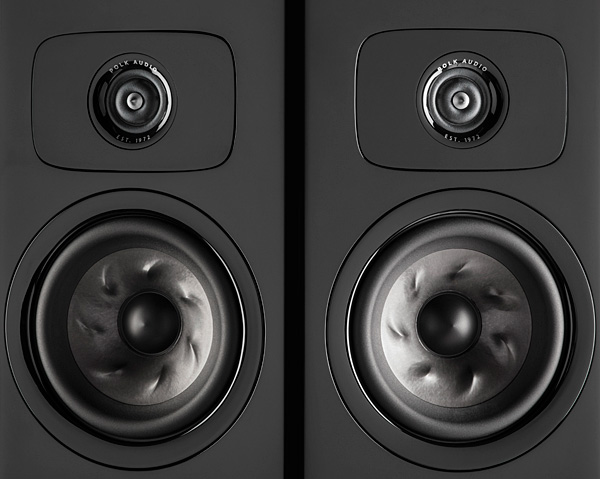
The specific tweaks made for SDA-Pro include a 15-degree angle to the speaker baffles for both the regular and Dimension driver arrays. This eliminates any need for speaker toe-in since it’s already built into the design. It also reduces cabinet width in comparison with earlier SDA models. Unlike earlier designs, the L800’s Dimension Array uses a tweeter to cover the extended bandwidth of the cancellation signal, though that signal is rolled off above 10kHz. Finally, SDA-Pro incorporates a Head Shadow Filter to account for the physical effects of
the listener’s head and face. While Polk Audio still uses a purely acoustic approach for SDA-Pro with no digital signal processing, the Dimension Array’s crossover is EQ’d to optimize the cancellation signal, with filtering normalized for the head shadow created by an average listener.
SDA-Pro isn’t the only thing that the L800 brings to the party. The tower’s substantial 17.9 x 48.6 x 17.4-inch (WxHxD) cabinet boasts exceptional build quality and uses real wood veneer finishes. My review sample was clad in a Brown Walnut that nicely matched my living room’s interior; the other available option is Black Oak. Magnetically attached black cloth speaker grilles are provided, though Polk Audio suggested that I leave them off for my review.
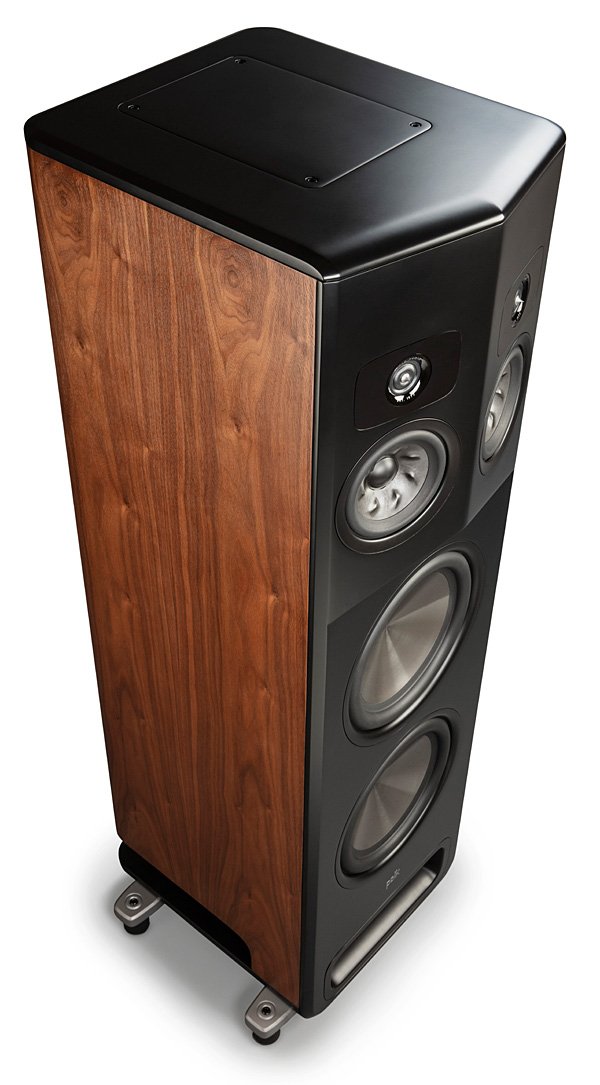
The L800’s dual driver array features the company’s new high-definition Pinnacle ring radiator tweeter. An evolution of the tweeter found in the company’s previous LSiM Series, it pairs a 1-inch ring with waveguides located at the center and outer edges. According to Polk Audio, the waveguides maximize dispersion and also smooth response by eliminating break-up modes typically generated by a central dome. A damped cavity behind the tweeter also helps to reduce resonances and “ringing” at 2.5kHz.
A 6.5-inch Turbine midrange driver developed for the Legend Series features a foam-core polymer-injected cone and an asymmetric geometry, both of which work to smooth out vibra- tional modes and resonances. This is located on the angled upper section of the L800’s baffle alongside the tweeter, while the tower’s lower section features a pair of 10-inch woofers.
The L800 features a bottom- mounted “Power Port” that maximizes cabinet space for increased air flow and reduced turbulence compared with conventional front or rear- mounted ports. Power Port, too, gets a refresh in the Legend Series, with redesigned port flare geometry meant to further increase bass output and reduce distortion.
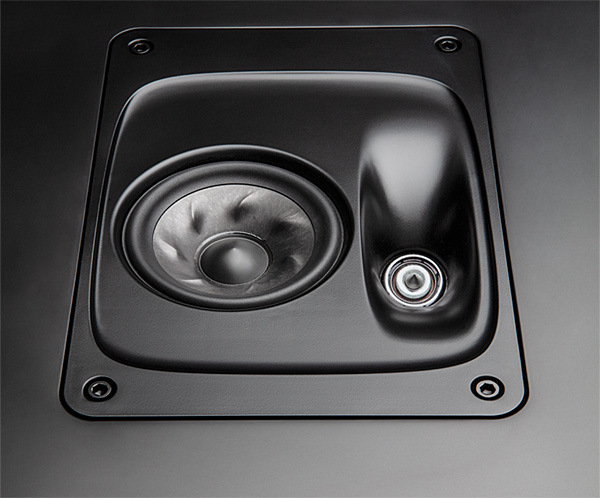
Both the L800 and L600 Legend towers feature a top- mounted panel that can be removed to install the company’s optional L900 height module speaker ($599/pair) for playback of Atmos/DTS:X and virtualized soundtracks. The module features a 0.75-inch version of the Pinnacle ring radiator tweeter and 4-inch Turbine Cone midrange/bass driver in a horizontal alignment that’s said to deliver a large sweet spot with immersive audio. Unlike some other elevation speakers that I’ve seen, Polk Audio’s option for the Legend towers offers an “invisible” solution, with the flush-mounted modules literally disappearing into the speaker’s top surface.
The L800’s rear panel input connections include dual gold-plated five-way binding posts with jumpers that can be removed for bi-amping. Another set of binding posts is provided for a height speaker input, and there’s a socket for the SDA-Pro cable that runs between the speakers and delivers the crosstalk-canceling signal to the left and right Dimension arrays, respectively. Each L800 tower comes with a 15-foot SDA-Pro cable, and while a single length should suffice for most setups, the two can be daisy chained for installations where the cable gets snaked through a wall or cabinet.
Setup
Setup of the L800 towers didn’t follow nearly the same template I’m used to when positioning speakers for best sound in my listening room. Not only is no toe-in required, but Polk Audio recommends that you place the towers 6-8-foot from one another—an unusually close distance. Such tight positioning ensures you are getting maximum effect from SDA-Pro, and it also reduces the impact of side walls and other reflective surfaces on the sound.
To confirm that the speakers were correctly aligned for my review, Polk Audio sent Scott Orth, the company’s Head of Audio and Acoustics, to assist with setup. Using various SDA-Pro-friendly music tracks Polk Audio engineers have culled from years of experience working with the technology, Scott painstakingly tweaked positioning, with the final result finding the towers approximately 6 feet from each other, five feet in from either side wall, and about 1 foot out from the back wall. The listening seat on my sofa, meanwhile, was located about 8 feet away from the speakers.
Rugged metal-and-rubber support feet on the bottom of L800 towers can be individually adjusted to level the speaker on uneven floor surfaces. Metal spikes are located inside the feet and can be swapped out for carpet installations by pulling off the feet. For my setup, the front surface of the towers was angled slightly downward at the listening position to bring the tweeters more in-line with my ears. In my room, there was no choice other than to have the SDA-Pro interconnect cable stretched on the floor between the towers, and although it wasn’t the tidiest-looking option, I soon forgot the cable was there at all.
Sources that I used for my listening included a Panasonic DMP-UB900 Ultra HD Blu-ray player for CD playback and a MacBook Pro running Roon to stream music from Tidal and Qobuz. I also used a Hegel Music Systems H390, a stereo integrated amplifier that’s spec’d at 2 x 250 watts into 8 ohms, but compatible with speakers down to 2 ohms. While Polk Audio states the L800 towers can be paired with amplifiers rated for anywhere from 25-300 watts per channel, the speaker’s 4 ohm nominal impedance indicated to me that opting for more power would be a good idea, and the Hegel H390 proved to be a more than suitable match.
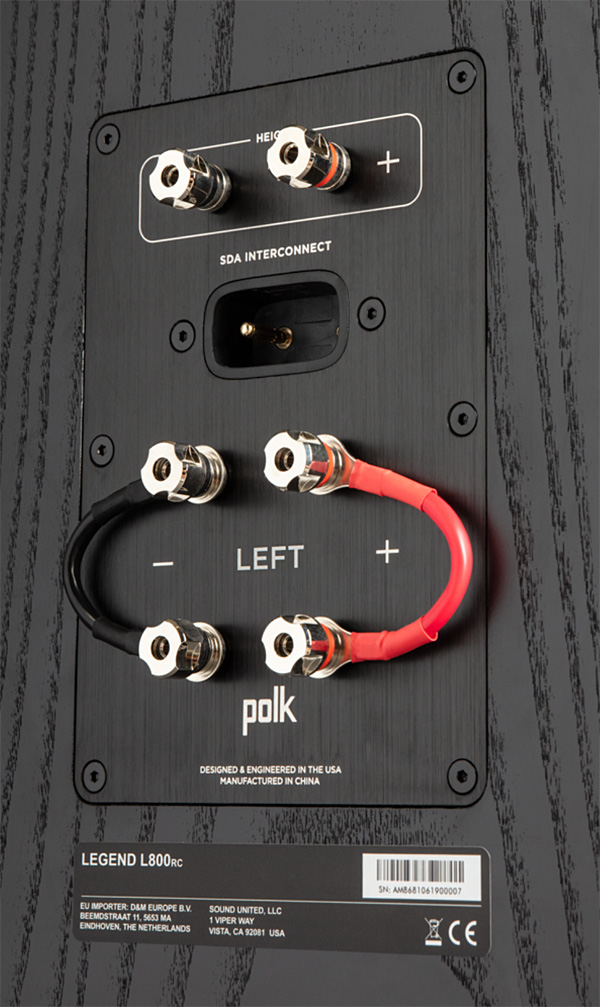
Performance
Since SDA-Pro is a key feature of the L800 towers, I first listened to a few tracks Polk Audio has used for its SDA-Pro demos, and also went searching through my own collection for content that would allow the tech to work its magic. The first cut I played was an audiophile classic, “Time,” from Pink Floyd’s The Dark Side of the Moon (CD layer of a multichannel hybrid SACD). A collage of clock chimes the song kicks off with literally exploded, the sound freed from the speakers and wrapping well to the left and right boundaries of my room and seemingly around my head. The effect was surround sound-like, but also free of front-to-rear continuity gaps that can accompany listening to multichannel music on a 5.1 system.
As the chimes in “Time” transitioned to a constant ticking, the sound emanated from a precise location directly between the speakers. This was followed by a huge wash of bass that the dual 10-inch woofers on the L800s delivered with impressive extension and power. The tom-tom flourishes contributed by drummer Nick Mason, meanwhile, floated down from impossibly high- and deep-seeming points in my listening room. While the effect of all this 1970s recording studio wizardry was dazzling, the L800’s presentation was in no way artificial or enhanced; I experienced the same “Time” I’m used hearing, but the sonic image now came across as wider, bigger, more 3D.
To confirm the naturalness of the L800’s SDA-Pro-enabled sound, I played Ray LaMontagne’s “Three More Days” from Till the Sun Turns Black, a CD I’m very familiar with that has a consistently expansive stereo mix, though not one that extends into Pink Floyd territory. The tightly centered placement of vocals, rhythm guitar, and electric bass in the mix as usual provided a firm foundation for the track. But the guitar leads extended out much further than I’m used to hearing with my regular speakers, and the horns in particular came across as notably tall and wide, with a sense of dynamic ease that I found very appealing. Same as with the Floyd track, I experienced a “wraparound” effect, though there was nothing gimmicky or unnatural about the presentation.
Leaving the natural world completely behind, I next played an electronic music track, Squarepusher’s “The Exploding Psychology,” from his Go Plastic CD. I’ve always been impressed by the ability of this cut, which is packed with a dense expanse of bloops and blips, to push the sound- staging limits of any speakers I happen to be listening with. The L800s painted the track’s electronic landscape in a strikingly vivid manner, with sound reverberating not just beyond the physical confines of the speakers but also seeming to erase the boundaries of the room’s ceiling and walls. A battery of synthesized beats in the song’s mid-section came across as highly dynamic, with deep-reaching bass that could be felt as well as heard.
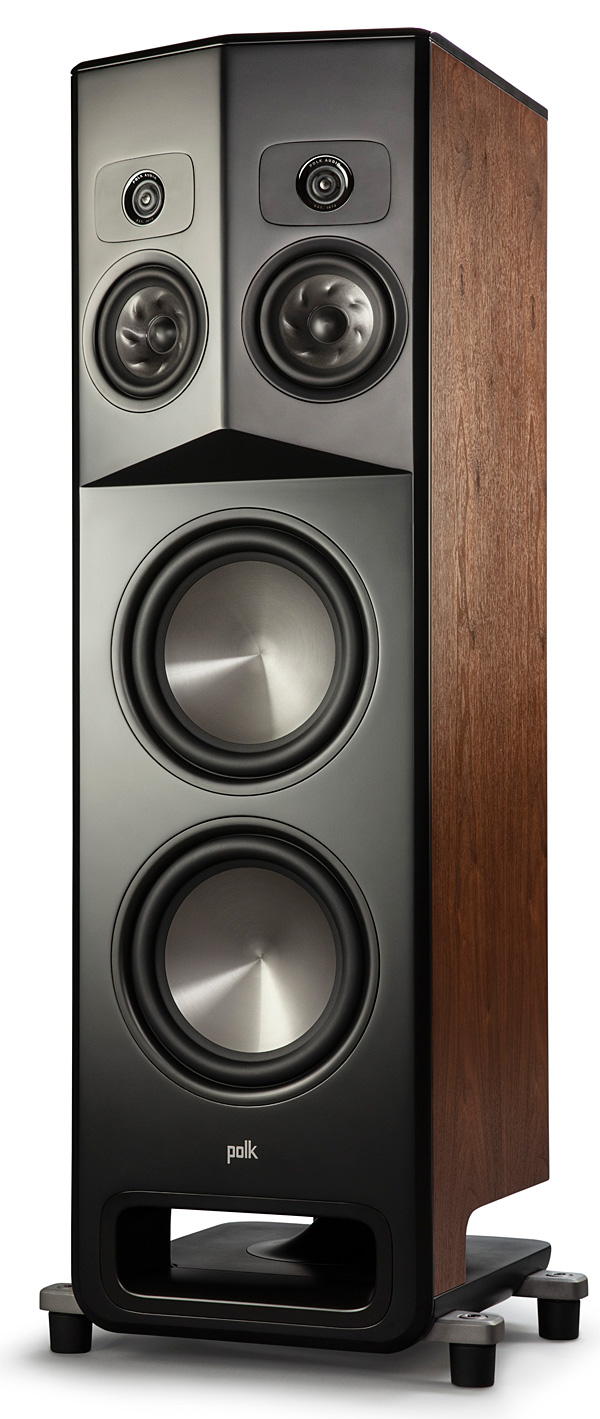
While SDA-Pro sure can make listening fun, it’s also true that not all recordings contain the spatial cues necessary to make them a showcase for the technology. Fortunately, the L800s have a neutral sonic balance that makes them a good match for most music. Listening to “For My Crimes,” (16-bit/44.1kHz Qobuz stream) a folky acoustic track by Boston-based singer-song- writer Marissa Nadler from her album of the same name, the vocals were presented cleanly and with excellent focus and good texture. The swells of cellos and wispy background vocals in the song’s chorus were impressively full-sounding, and I experienced the same sense of dynamic ease that I heard on the Ray LaMontagne track. On this and some other music I listened to, I felt the sound could be borderline bright, but that judgement was highly dependent on the content. If anything, I found the L800s to have a revealing presentation that exposed harsher-sounding tracks for what they are rather than glossing them over with overly smooth treble response.
Polk Audio’s flagship towers continued to impress when I used them for classical music listening. When I next streamed Estonian composer Arvo Pärt’s De Profundis as performed by the Hilliard Ensemble, (Qobuz, 16/44.1), the choral parts were rendered with excellent clarity and I heard a good sense of layering between the massed voices, organ, and percussion. The ambience of the space (captured beautifully on this ECM release) came through in a realistic manner that allowed me to appreciate the not just the music, but the setting where the recording was made.
Conclusion
Polk Audio’s flagship Legend series L800 tower is an exceptionally well-built speaker that offers appealingly neutral sound and full-range performance. And at $6,000, it’s priced at a level that lets it compete with high-performance towers from other, similarly value-oriented audio companies. While the L800’s somewhat bulky design bucks the current trend toward slim speakers, I thought that it looked great in my listening room, where the real wood veneer cabinet blended perfectly with the surrounding environment.
Of course, the speaker’s somewhat wide cabinet is necessary for the SDA-Pro to do its work, and SDA-Pro is what provides much of the fun when listening with the L800s. During my time with them, I eagerly scoured my CD and streaming libraries for music that would lend itself well to the stereo image-expanding technology. In many cases I was enthralled by what I heard, and I can say with confidence that anyone else who experiences the L800s will have a great time listening to their collection with fresh ears and a fresh sense of purpose. Polk Audio clearly packed a lot of history, effort, and love into its new statement speaker, and that high level of enthusiasm is reflected in the sound.
